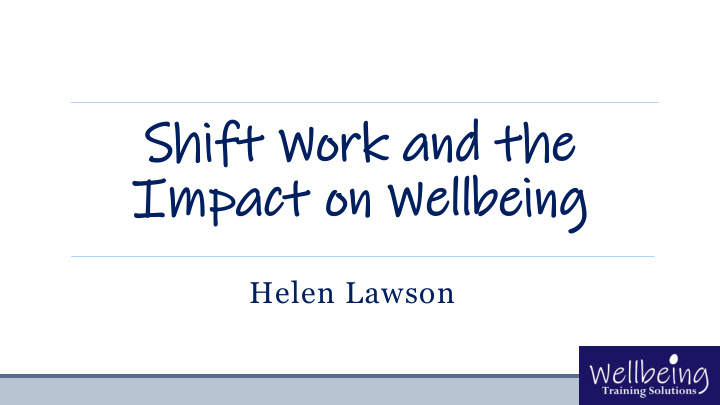



Shift Work and the Impact on Wellbeing Helen Lawson
Objectives • Shift work in context & key guidance (UK) Known negative impacts associated with shift work • How to support shift workers using a wellbeing • framework The benefits of getting wellbeing right, for shift • workers, other workers and organisations 2
What is Shift Work? • No one specific definition; • Work outside standard hours (normally between 7am – 7pm, 8hrs, with lunch break), maybe with a handover • One employee replaces another on same job in 24 hours • Extended periods of 12 hrs + • Rotating shifts • Split shifts • Overtime/Standby/On-Call 3
Context & Guidance • Approx 3.6 million shift workers (14% of working pop) Managing shiftwork, Health and Safety guidance, HSE • • Working Time Regulations (WTR) – some exemptions Railway and Other Guided Transport Systems (Safety) • Regulations • Management of Health and Safety at Work Regulations Health and Safety at Work Act • 4
What is Wellbeing? • Subjective - a state of mind Being comfortable, healthy &/or happy over time • It’s not just the absence of illness or disease • Physical and mental wellbeing • • A little reflection … On a scale of 1 to 10 ….. 5
Levels of Wellbeing Intervention • Primary – helps whole groups - woven into business design, org etc. Eliminates or reduces stress/negative wellbeing impacts at source Secondary – targeted – often training based. • Useful where primary isn’t possible • Tertiary – targeted – should be used in addition to above. May include Employee Assistance Programmes (EAPs) 6
Employer Responsibilities for Shift Workers • Protect health, safety & welfare of all employees and others Assessment of risks • Consult with employees • Commit to measures which reduce risks • including; • No. of hours • How they are scheduled 7
Employer Opportunity Consultation/leadership “The wise man doesn’t give the right answers, he poses the right questions.” Claude Lévi-Strauss (1908-2009) 8
Leadership & Listening? Empathic Attentive Selective Pretending Ignoring Stephen Covey 9
Employee Responsibilities • Take reasonable care of own and others safety • Take positive steps to understand the risk factors in their work including; • Fatigue Compliance with safety rules • Do nothing to put others at risk • 10
Are you Supporting Them? Capability + Opportunity + Motivation Behaviour Susan Michie, COM-B Model 11
Shift Work Negatives for Businesses • Poor performance • Likelihood of errors • Accidents • BUT – there are always opportunities Growth mindset • Marginal gains (Dave Brailsford) • 12
Minimising Business Shift Work Negatives • Review organisational practices • Create a supportive infrastructure • Check your COM-B model compliance • Leadership – do they know stuff or staff? • Is competition an organisational tactic? • Create a shared vision & community • Psychological safety is paramount 13
Individual Negative Impacts of Shift Work • Disruption to circadian rhythms (body clock) • Sleep disturbance/loss • Fatigue • Disturbed appetite and digestion • Reliance on sedatives and/or stimulants • Social/domestic problems • Relationships at work 14
Minimising Individual Impacts • Raise awareness of potential negative impacts Educate on how to minimise e.g. sleep hygiene, diet, • alcohol, stimulants and sedatives etc. Explain biology/scarce neurological resources • Highlight significance of stress – good and bad • • Self awareness, emotional intelligence, listening, constructive comms for work and home 15
Health Inequalities • Unfair, avoidable, differences across population • 9.3 years < for men 7.5 years < for women (Health Profiles) • Wider determinants of health - education, • income, housing and employment • May have lower awareness of/access to services • May lack essential skills (Skills Builder F/W) 16
Shift Worker Health Risks • Gastrointestinal – indigestion, constipation Hypertension and Coronary Heart Disease • Colds, flu, gastroenteritis • Female reproductive issues • May affect pre-existing conditions – diabetes/asthma • • Dose response effect of meds (circadian rhythms) 17
Supporting Shift Worker Health • Provide free health assessments (WTR) Continually promote what is available (EAP) • Promote free resources (e.g. NHS Health Checks) • Health promotion – men’s health, BP, smoking • Educate on self care and health management • • Parity of esteem – physical and mental health 18
Mental Wellbeing Adapted from Stephen Covey, Seven Habits of Highly Effective People 19
Support Positive Change Thoughts Behaviours Feelings 20
Supporting Shift Workers Wellbeing • Sickness and absenteeism including lost-time incidents Accidents • • Compensation claims Efficiency • • Quality • Productivity • Performance • Engagement Discretionary effort • 21
Strategic Workplace Wellbeing Mind Body + ? Money Community 22
In Summary • Shift work poses real risks which must be managed For every challenge, there is an opportunity • Look to achieve marginal gains • Consider the value of a wellbeing approach • • What if you invest in them and they leave? • What if you don’t and they stay? 23
Any questions? 24
Useful Information • Skills Builder Framework – Universal Framework for Essential Skills - https://www.skillsbuilder.org/ • Health Profiles - https://fingertips.phe.org.uk/profile/health-profiles • NHS Health Checks - https://www.healthcheck.nhs.uk/ • Smoking Cessation - https://www.nhs.uk/smokefree 25
Contact Details Helen Lawson Workplace Wellbeing Specialist, Trainer, Speaker and Author E helen@wellbeingts.co.uk W www.wellbeingts.co.uk www.linkedin.com/in/helen-lawson-educator @wellbeingtrainingsolutions 26
Recommend
More recommend